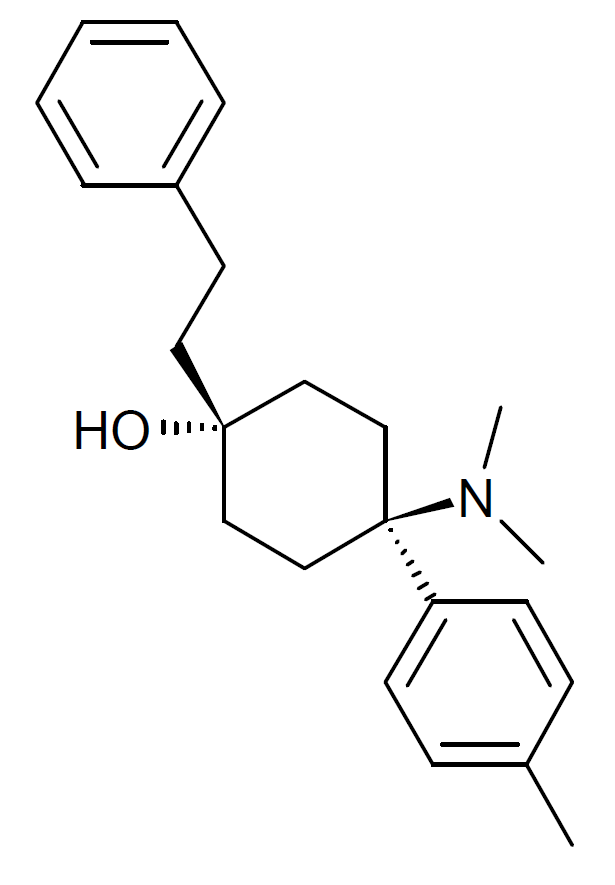Summary
BDPC, also known as bromadol, is a highly potent narcotic analgesic characterized by its unique arylcyclohexylamine chemical structure. This compound was initially developed by Daniel Lednicer at Upjohn during the 1970s.
Early investigations suggested that BDPC exhibited a staggering potency, estimated to be approximately 10,000 times stronger than morphine in animal models. However, subsequent studies utilizing more advanced techniques determined that the more active trans-isomer of BDPC possessed a potency roughly 504 times that of morphine.
In a significant development, BDPC was first intercepted alongside three kilograms of acetyl fentanyl during a police operation in Montreal, Canada, on April 25, 2013. Since then, it has continued to surface on the international designer drug black market.
Notably, analogs of BDPC that feature substitutions, such as chlorine or a methyl group in place of the para-bromine, maintain similar pharmacological activity. This also holds for derivatives with a meta-hydroxyl group.
| Identifiers | |
|---|---|
| IUPAC name | |
| CAS Number | 77239-98-6 70895-01-1 (HCl) |
|---|---|
| PubChem CID | 9887338 |
| ChemSpider | 8063011 |
| UNII | G8HCJ9R4VZ |
| ChEMBL | ChEMBL3303774 |
| Chemical and physical data | |
| Formula | C22H28BrNO |
| Molar mass | 402.376 g·mol−1 |


FAQ
- What is BDPC?
- BDPC, or tramadol, is a highly potent narcotic analgesic with a unique chemical structure known as arylcyclohexylamine. It was initially developed in the 1970s.
- How potent is BDPC compared to morphine?
- Initial studies suggested that BDPC could be around 10,000 times more potent than morphine in animal models. However, subsequent research using modern techniques determined that the more active trans-isomer of BDPC is approximately 504 times as powerful as morphine.
- Where was BDPC first seized?
- BDPC was first seized in an operation in Montreal, Canada, on April 25, 2013, along with three kilograms of acetylfentanyl.
- Is BDPC still available on the black market?
- Yes, BDPC has reportedly continued to be available on the designer drug black market internationally.
- Are there any related compounds or analogs of BDPC?
- Yes, there are analogs of BDPC in which the para-bromine atom is replaced by either chlorine or a methyl group. Additionally, derivatives with a meta-hydroxyl group maintain similar pharmacological activity.
- Is BDPC legal for use or distribution?
- The legal status of BDPC varies by country and jurisdiction. It is important to note that the legality of substances like BDPC can change, and it may be considered illegal in many places due to its potential for abuse and high potency.
- Is BDPC used for medical purposes?
- BDPC is not approved for medical use and is primarily encountered as a designer drug in illicit markets.
- What are the potential risks associated with BDPC use?
- Using potent opioids like BDPC can lead to a range of health risks, including addiction, overdose, and respiratory depression, which can be life-threatening. It is crucial to avoid the use of such substances.
- Is there any ongoing research on BDPC?
- Research on BDPC may continue in forensic and toxicological contexts to understand its effects and prevalence in illegal markets. However, there needs to be more legitimate research into its medical applications.
- Is harm reduction necessary when dealing with BDPC or similar substances?
- Yes, harm reduction strategies are crucial when addressing potent opioids like BDPC. These strategies can include education, prevention, treatment, and support services to reduce the harm associated with their use.
References
- US Patent for Novel Analgesics: In 1982, a patent (US 4366172) was issued to Daniel Lednicer, assigned to the Upjohn Company, for “4-Amino-cyclohexanols, their pharmaceutical compositions, and methods of use.” This patent is related to a series of novel analgesics.
- Potent Analgesic Discovery: In October 1979, Lednicer and VonVoigtlander published a study describing “4-(p-Bromophenyl)-4-(dimethylamino)-1-phenethylcyclohexanol,” an extremely potent representative of a new analgesic series. This research contributed to the development of potent opioids.
- Exploring Opioid Activity: A study from May 2003 discussed the opioid activity of a compound known as C8813, highlighting its novel and potent opioid analgesic properties.
- Appearance on the Black Market: In May 2013, there was a report of an extremely potent painkiller, likely referring to BDPC, hitting the black market in Montreal. This raised concerns about the availability of powerful designer opioids.
- Monitoring Novel Synthetic Opioids: As of January 2019, researchers were actively monitoring the illicit drugs market for the emergence of new synthetic opioids, particularly those with euphoric effects. This reflects ongoing efforts to understand and address the evolving landscape of designer drugs.
- In Vitro Characterization of New Psychoactive Substances: In November 2020, a study focused on characterizing the in vitro functional properties of several non-fentanyl opioid new psychoactive substances. This research contributes to the understanding of the pharmacological properties of these substances.
- Development of Novel Analgesics: In April 1981, Lednicer and colleagues published research on “4-amino-4-arylcyclohexanones,” introducing a novel class of analgesics. This work explored modifications to the carbonyl function to enhance the analgesic properties.
- m-Hydroxyphenyl Derivatives: In March 1981, Lednicer and collaborators expanded on their work, investigating “4-aryl-4-aminocyclohexanones and their derivatives.” This research specifically explored derivatives with m-hydroxyphenyl groups, which held promise as analgesics.